-
Posts
78 -
Joined
-
Last visited
Content Type
Profiles
Forums
Store
Gallery
Events
Local Fish Stores
FAQ
Blogs
Downloads
Posts posted by Kingfish
-
-
Ben, i will inquire about this when I call Pacific Garden Supply this week.
-
MORE NOG PICS!!!
-
That's what she said.
-
You have got to be joking, 34 as in thirty-four. I will have to see a picture of this. You know that one (1) 2x4 can stand over 1300lbs of vertical pressure.
-
Maybe in late Feb. we are really swamped with our own projects for the store.
-
That tank will be fine unbraced w/ 1/2 glass, esp. being only 20" tall
-
quite ones run as warm as the mags, if you don't expect to see a chiller under your xmas tree, think about and eheim 1260, even if you buy it used, it is a great long lasting pump.
Another alternative is the aquamedic oceanrunners. they are an under publicized pump that runs cool and pumps out a good flow as long as there isn't much head pressure
-
Ben, progress has come to a complete halt. We took 5 days off for thanksgiving and now I have a huge Holiday-hangover (no alcohol involved). When I get motivated I'll give you a call.
-
village tropical, city pets, global pets, aquarium world, aquatic world, fish ranch.
Where's Big Bird when you need him?
-
Here is what i have for you Brian.


-

Blue low iron starfire glass

A.G.E. aquarium from Dallas
-
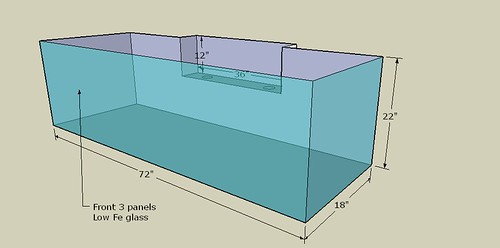
Here is the design for clint's new tank.
-
On the one hand, the easy answer is to just say electronic ballasts are more energy efficient b/c they do use less power to fire the same bulb as a magnetic. Electronic ballasts ignite MH bulbs 100's of times per second while magnetic ballasts are on all of the time. The increments of time in between "pulses" saves energy and $$$.
On the other hand, magnetic HQI ballasts like the PFO use a similar igniter but put out more heat. Any time heat is produced, there is energy loss. The benefit of the PFO type magnetic ballasts is that they overdrive MH bulbs to produce more PAR (photosythetically active/available radiation). So the real question that you have to ask when choosing a ballast is, how much energy per PAR unit is used. Surely Sanjay Joshi has answered this question. Electronic ballasts are great b/c they are small and easy to mount. But if you really want to rock out an SPS tank, the single best ballast is the sunlight supply blue wave IV. It outputs 270w to drive a 250, or 430w to drive a 400w halide. I have seen a dual one of these running 2 x 400w coralvue reeflux 12K's and it ROCKS! It uses a bit more electricity, but who cares about a little electricity when you have a 5 or $10,000 reef tank with $1000's of dollars in corals?
-
Gabe said it; "they need a stable tank." Anems deflate because of gradients (differences) in water parameters between the inside and outside of the anemones tissue. In a newer tank, esp. one with algae blooms, hair algae etc., oxygen saturation is in constant flux due to algae photosynthesis. Algae uses CO2 during the day and oxygen at night, causing rapid and frequent changes in pH. This causes the anem. to regulate its osmotic balance, ( water inside and outside of its tissue). The more change in the tank the more the anem. has to adapt (deflate). You can't really control this in a new tank, just hope for the best.
This is the case with most anemones. The magnificent anemone (Heteractis magnifica) aka the ritteri anemone, is a totally different story. This an organism, that for years, experts and hobbiests alike have struggled to keep this thing alive for longer than a month or two (if not just mere weeks). My opinion on ritteris, as well as Anthony Calfo's, is that buying, selling, attempting to keep ritteris is irresponsible reefkeeping. These organisms should not be sold in LFSs, if they happen to be in a local LFS, don't buy it no matter the price. Let it die at the LFS to teach the retailer a lesson to not order these again.
If you respond to this post with, " but i've had a ritteri for 6 months," also include how many you had to kill to keep that one alive. The one at the store that I used to work at, that is so famous here in austin, was like the 6th or 7th yellow ritt. that was killed to get just one to survive. That was 7 years ago, now you couldn't even get ahold of 7 yellow ritteris no matter how much money you have.
-
The stand is done and stained with a one step stain and polyurethane. I started the tank today and was able to get the sides glued together. i used the Weld on #4 with guitar wire (#8). I positioned the panels with the wire in the joint and positioned the clamps. It was 74 F inside the store, so I had to work fast. After dripping the weld on in, i waited 30 seconds and pulled the wire out of the joints. I waited 60 more seconds and clamped the joints firmly, but not so much that too much glue came out of the joint.
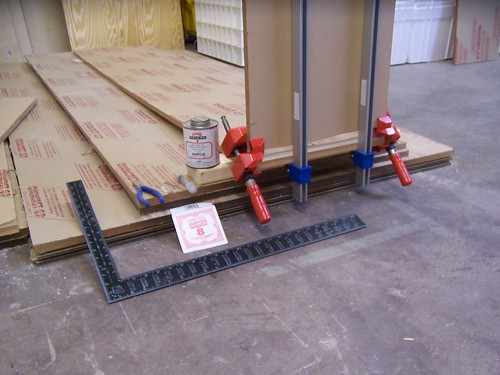
materials: razor blade, syringe, WO #4, Square, masking tape, clamps, kleenex, Ernie Ball 8 wire.
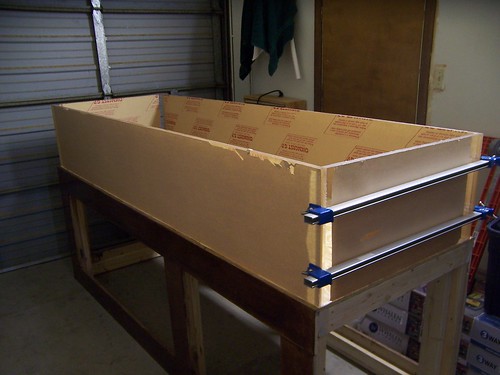
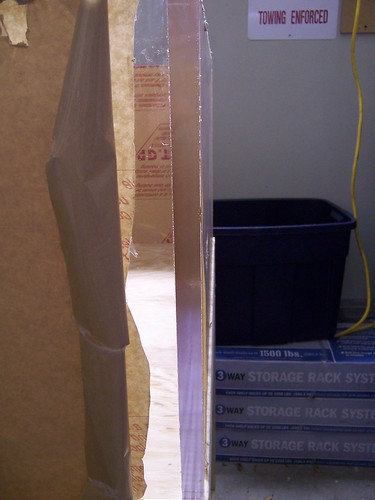
My technique has improved, no air bubbles this time. I used some of Ben's advice.
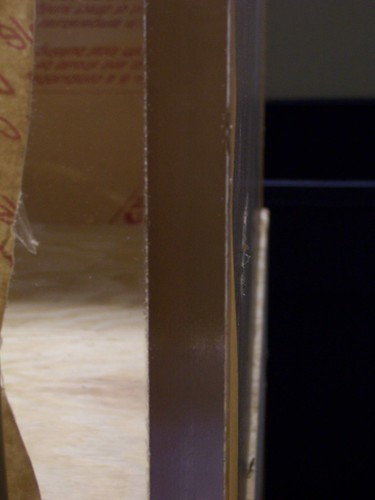
-
Don't worry ben, i am going to use toothpicks and a gluestick for the next one. You know I believe in over-engineering (sarcasm).
-
I think i'll let john build the tank. Pics to follow.
-
Looks like these anthias are a dim light sp. seeing as how they come out more after the lights turn off. They finally ate this evening, they wouldn't touch the mysis, but they didn't feed on H2o life frozen cyclops.
-
As many of you may know I am building two coral holding tanks for our store. I figured i would take pics and give some instruction along the way in case anyone is interested. The tanks will be 96" L x 32" W x 16" H and hold around 200 gallons each. I decided on these measurements because a standard acrylic sheet is 48"x96" . With a 32x96 base that leaves a 16x96 piece left for one of the sides. A tank of this size requires only two sheets of acrylic. With heavy bracing, this tank could be built out of 3/8 or 1/2 inch. As we all know, bracing sucks, so I am building these out of 3/4 cast acrylic. The cost per sheet was around $350, and the materials for the stand was about $90. So about $800 per tank and stand combo.
The first pic is some 1/2 plywood with 2x4's framed around the perimeter, glued and screwed with 1 5/8 drywall screws. I attached the 2x4's together with 3" course drywall screws. All screw holes were predrilled with a hitachi counter sink bit.
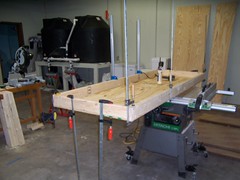
next i added cross members for additional support
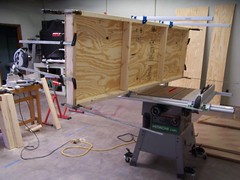
After that I began to attach 32" legs with wood glue and the 3" drywall screws.
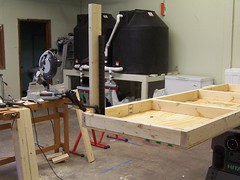
Here is a pic with all the legs attached and begining to attach lower bracing.
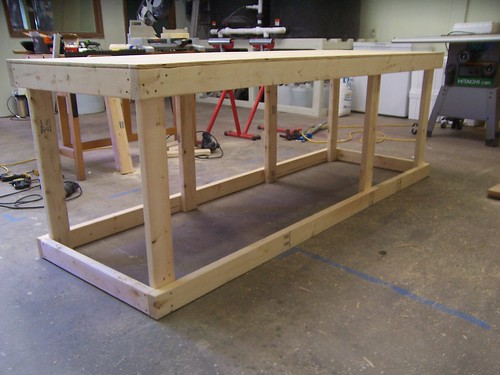
The 2x4" support structure is done , so i began adding the plywood facing. i used 3/4" Blondewood from the Shoal Creek Lowe's ($25/sheet)
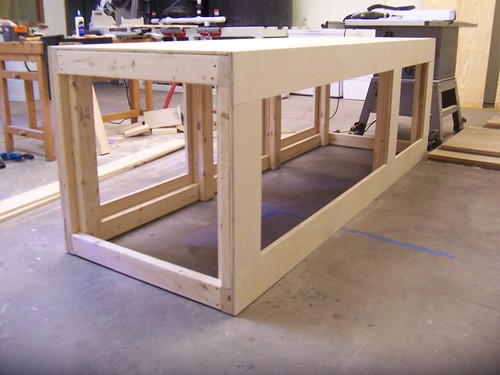
All the facing wood on.
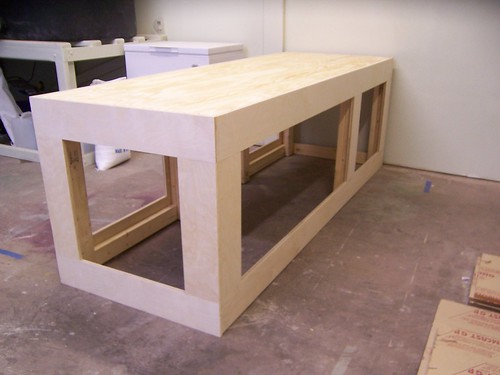
Another angle.
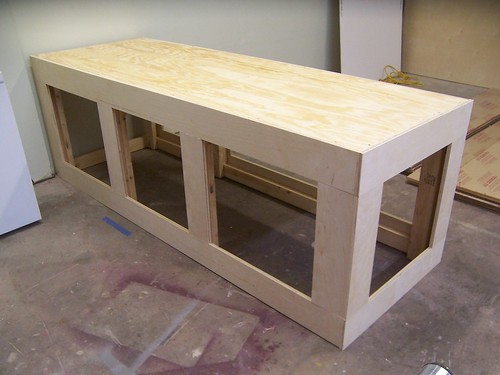
Once I had all the materials back at the shop, the stand took about 3 hours to build.
-
Anyone have any experience with the tuka anthias? sorry I don't have a picture, but they are purple with a yellow dorsal stripe.
Preferred foods etc?
-
I agree, they look like cerith snail eggs and pose no harm.
-
24/7 is sort of the default answer/setting for lighting a fuge, but I believe that the light cycle should be altered based on the pH of the tank. If the pH is stable, by all means light the fuge 24 hrs. If there is a 0.3 to 0.5 or higher swing, then consider lighting the fuge 12-18 hrs on the reverse cycle.
Here is a question for everyone, Is there any reason to use any type of algae other than Chaeto. It grows fast, harvests nutr. and doesn't/rarely goes sexual, and does well with shading. Why use any Caulerpa sp.?
-
Stephen, where exactly do you live again? maybe we should just take a look at it. Or can you bring some pics, or a dig. cam to the meeting so we can take a look.
On the topic of sumps; i have 3 words: sump, skimmer, return pump, thats it.
-
I have used HW marine mix for years. I started my first reef tank with it 6 years ago and have used it off and on with I.O. and Oceanic. I do not think that it is worth the extra money, and have had better results with Oceanic.
Plus, the batches have been inconstant for me, with some batches mixing clear and some precipitating calcium. It is $69.99 for a 150g mix, so it is quite expensive.



Chaeto turning red
in Reef Keeping
Posted
Thats def. Cotton candy, do not let it get into the main tank at all cost. Even though yellow tangs and some turbos eat it.